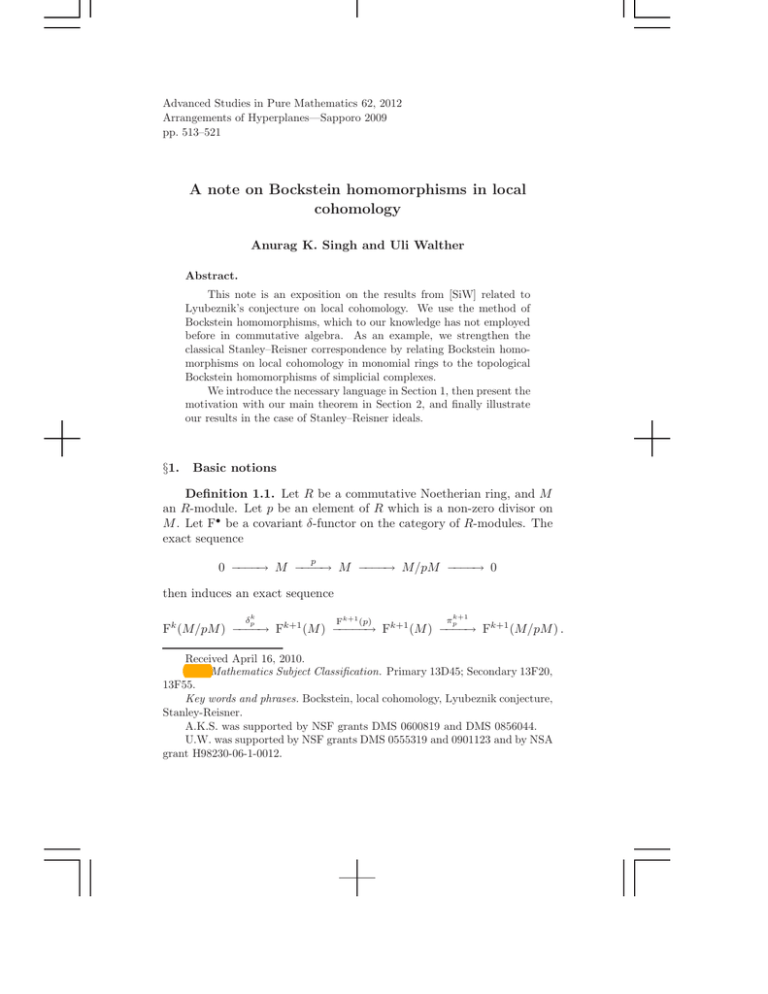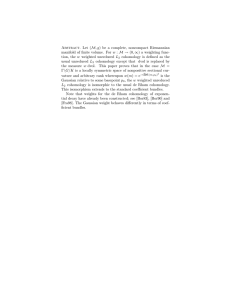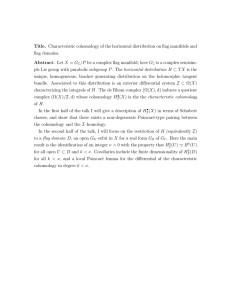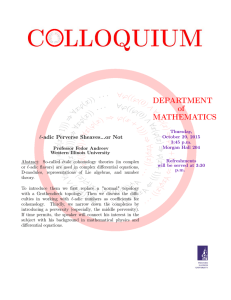A note on Bockstein homomorphisms in local cohomology
advertisement

Advanced Studies in Pure Mathematics 62, 2012
Arrangements of Hyperplanes—Sapporo 2009
pp. 513–521
A note on Bockstein homomorphisms in local
cohomology
Anurag K. Singh and Uli Walther
Abstract.
This note is an exposition on the results from [SiW] related to
Lyubeznik’s conjecture on local cohomology. We use the method of
Bockstein homomorphisms, which to our knowledge has not employed
before in commutative algebra. As an example, we strengthen the
classical Stanley–Reisner correspondence by relating Bockstein homomorphisms on local cohomology in monomial rings to the topological
Bockstein homomorphisms of simplicial complexes.
We introduce the necessary language in Section 1, then present the
motivation with our main theorem in Section 2, and finally illustrate
our results in the case of Stanley–Reisner ideals.
§1.
Basic notions
Definition 1.1. Let R be a commutative Noetherian ring, and M
an R-module. Let p be an element of R which is a non-zero divisor on
M . Let F• be a covariant δ-functor on the category of R-modules. The
exact sequence
p
0 −−−−→ M −−−−→ M −−−−→ M/pM −−−−→ 0
then induces an exact sequence
δpk
Fk+1 (p)
πpk+1
Fk (M/pM ) −−−−→ Fk+1 (M ) −−−−−→ Fk+1 (M ) −−−−→ Fk+1 (M/pM ) .
Received April 16, 2010.
2010 Mathematics Subject Classification. Primary 13D45; Secondary 13F20,
13F55.
Key words and phrases. Bockstein, local cohomology, Lyubeznik conjecture,
Stanley-Reisner.
A.K.S. was supported by NSF grants DMS 0600819 and DMS 0856044.
U.W. was supported by NSF grants DMS 0555319 and 0901123 and by NSA
grant H98230-06-1-0012.
514
A. K. Singh and U. Walther
The composition
πpk+1 ◦ δpk : Fk (M/pM ) → Fk+1 (M/pM )
is the Bockstein homomorphism βpk = βpk (F (M )).
An elementary check shows that βpk is the connecting homomorphism
that results from applying F• to the short exact sequence
p
0 −−−−→ M/pM −−−−→ M/p2 M −−−−→ M/pM −−−−→ 0.
Let a be an ideal of R, generated by elements f1 , . . . , ft . The covariant δ-functors of interest to us are local cohomology Ha• (−), Koszul
cohomology H • (f1 , . . . , ft ; −), and Ext•R (R/a, −) discussed briefly below.
Setting f e = f1e , . . . , fte , the Koszul cohomology modules H • (f e ; M )
are the cohomology modules of the Koszul complex K • (f e ; M ). For each
e ≥ 1, one has a map of complexes
K • (f e ; M ) → K • (f e+1 ; M ) ,
and thus a filtered directed system {K • (f e ; M )}e≥1 . The direct limit of
this system can be identified with the Čech complex Č • (f ; M ) given by
!
!
0→R→
Rfi →
Rfi fj → · · · → Rf1 ···ft → 0 .
i
i<j
The local cohomology modules Ha• (M ) may be computed as the cohomology modules of Č • (f ; M ), or equivalently as the direct limit of the
Koszul cohomology modules H • (f e ; M ): the filter condition yields an
isomorphism of functors
H k (f e ; −) ,
Hak (−) ∼
= lim
−→
e
and each element of Hak (M ) lifts to an element of H k (f e ; M ) for e & 0.
Remark 1.2. Let F• and G• be covariant δ-functors on the category
of R-modules, and let τ : F• → G• be a natural transformation. The
Bockstein homomorphism is functorial:one has a commutative diagram
Fk (M/pM ) −−−−→ Fk+1 (M/pM )
τ
τ#
#
Gk (M/pM ) −−−−→ Gk+1 (M/pM ) ,
Bockstein homomorphisms
515
where the horizontal maps are the respective Bockstein homomorphisms.
With a = (f1 , . . . , fk ), the natural transformations of interest to us are
Ext• (R/ae , −) → Ha• (−) ,
H • (f e ; −) → H • (f e+1 ; −) ,
and
H • (f e ; −) → Ha• (−) .
Let M be an R-module, let p be an element of R which is a non-zero
divisor on M , and let f = f1 , . . . , ft and g = g1 , . . . , gt be elements of
R such that fi ≡ gi mod p for each i. One then has isomorphisms
H • (f ; M/pM ) ∼
= H • (g; M/pM ) .
Example 1.3. Let p be a non-zero divisor on R. Let x be an
element of R. The Bockstein homomorphism on Koszul cohomology
H • (x; R/pR) is
(0 :R/pR x) = H 0 (x; R/pR) → H 1 (x; R/pR) = R/(p, x)R
r
mod (p) (→ rx/p
mod (p, x) .
Let y be an element of R with x ≡ y mod p. Comparing the Bockstein
homomorphisms β, β " on H • (x; R/pR) and H • (y; R/pR) respectively,
one sees that the diagram
$
0 :R/pR
&
&
&
$
0 :R/pR
%
β
x −−−−→ R/(p, x)R
&
&
&
!
%
β
y −−−−→ R/(p, y)R
commutes if and only if (x − y)/p ∈ (p, y)R.
A key point in the proof of Theorem 2.2 is Lemma 1.4, which
states that upon passing to the direct limits lime H • (f e ; M/pM ) and
−→
lime H • (g e ; M/pM ), the phenomenon of Example 1.3 disappears: the
−→
Bockstein homomorphisms always commute with the induced isomorphisms
lim H • (f e ; M/pM ) ∼
H • (g e ; M/pM ) .
= lim
−→
−→
e
e
On the other hand, one has the following lemma.
516
A. K. Singh and U. Walther
Lemma 1.4 ([SiW]). Let M be an R-module, and let p be an element
of R which
is M -regular. Suppose a and b are ideals of R with
√
√
(a + pR) = (b + pR). Then there exists a commutative diagram
· · · −−−−→ Hak (M/pM ) −−−−→ Hak+1 (M/pM ) −−−−→ · · ·
#
#
· · · −−−−→ Hbk (M/pM ) −−−−→ Hbk+1 (M/pM ) −−−−→ · · ·
where the horizontal maps are the respective Bockstein homomorphisms,
and the vertical maps are isomorphisms.
§2.
Motivation and main result
Huneke [H, Problem 4] asked whether local cohomology Ha• (R) modules of Noetherian rings R have finitely many associated prime ideals.
Suppose p is a prime number such that the Bockstein homomorphism
βpk : Hak (R/pR) → Hak+1 (R/pR)
is nonzero. Clearly, Hak+1 (R) must then have an associated prime containing p. But different prime numbers cannot be in the same associated prime ideal, so Huneke’s conjecture implies the vanishing of all but
finitely many βpk with p a prime number.
Example 2.1. Consider the hypersurface
R = Z[u, v, w, x, y, z]/(ux + vy + wz)
and ideal a = (x, y, z)R. A variation of the argument given in [Si2] shows
that
βp2 : Ha2 (R/pR) → Ha3 (R/pR)
is nonzero for each prime integer p. Hence, Ha3 (R) has infinitely many
associated primes
Lyubeznik conjectured in [L1, Remark 3.7] that for regular rings
R, each local cohomology module Hak (R) has finitely many associated
prime ideals. This conjecture has been verified for regular rings of positive characteristic by Huneke and Sharp [HS], and for regular local rings
of characteristic zero as well as unramified regular local rings of mixed
characteristic by Lyubeznik [L1, L2]. Surprisingly, it remains unresolved
for polynomial rings over Z where the issue of p-torsion appears to be
central in studying Lyubeznik’s conjecture. The following theorem provides supporting evidence for Lyubeznik’s conjecture.
Bockstein homomorphisms
517
Theorem 2.2 ([SiW]). Let R = Z[x1 , . . . , xn ] be a polynomial ring
in finitely many variables over the ring of integers. Let a = (f1 , . . . , ft )
be an ideal of R, and let p be a prime integer.
If p is not a zero divisor on the Koszul cohomology module H k+1 (f ; R),
then the Bockstein homomorphism βpk : Hak (R/pR) → Hak+1 (R/pR) is
zero.
We outline the proof of Theorem 2.2. One investigates the endomorphism ϕ of R with ϕ(xi ) = xpi for each i. Since
p
H k+1 (f ; R) −−−−→ H k+1 (f ; R)
is injective and ϕ is flat, it follows that
p
H k+1 (ϕe (f ); R) −−−−→ H k+1 (ϕe (f ); R)
is injective for each e ≥ 0. Thus, the Bockstein map on Koszul cohomology
H k (ϕe (f ); R/pR) −−−−→ H k+1 (ϕe (f ); R/pR)
must be the zero map. While {ϕe (f )R} and {f e R} are not cofinal
families of ideals, Lemma 1.4 allows to replace one by the other for the
purpose of studying Bockstein homomorphisms on local cohomology.
Suppose η ∈ Hak (R/pR). Then η has a lift in H k (ϕe (f ); R/pR) for
large e, and the commutativity of the diagram
H k (ϕe (f ); R/pR) −−−−→ H k+1 (ϕe (f ); R/pR)
#
#
k
−−−−→
H(ϕ
e (f )) (R/pR)
#
k
H(f
) (R/pR)
−−−−→
k+1
H(ϕ
e (f )) (R/pR)
#
k+1
H(f
) (R/pR) ,
(each horizontal map is a Bockstein homomorphism) implies that η maps
to zero in Hak+1 (R/pR).
§3.
Stanley–Reisner theory
Definition 3.1. Let ∆n be the n-simplex, viewed as a simplicial
complex (i.e., with its collection of faces), and fix a subcomplex ∆. Then
the associated Stanley–Reisner ideal is the ideal
a∆ = (xσ | σ +∈ ∆) ⊆ R
518
A. K. Singh and U. Walther
'
generated by the monomials xσ = ni=0 xσi i for which σ is not a face of
∆. The quotient S∆ = R/a∆ is the Stanley–Reisner ring of ∆.
For a ∈ Zn+1 write a+ and a− for the sets {i | ai > 0} and {i | ai <
0} respectively. Both can be viewed as subsimplices of ∆n . Hochster’s
theorem, [BH, Section 5.3] states the following, with notation explained
below:
%
$ i
Hm (S∆ /pS∆ ) a = H̃ i−|a− |−1 (link'∆ (a+ ) (a− ); Z/pZ).
Definition 3.2. Let ∆ be a simplicial complex and suppose τ is
a subset of its vertex set (but not necessarily a simplex). The link,
link∆ (τ ), is the set
link∆ (τ ) = {τ " | τ ∩ τ " = ∅,
τ ∪ τ " ∈ ∆},
while its star, ((τ ), is simply
(∆ (τ ) = {τ " | τ ∪ τ " ∈ ∆}.
The Bockstein construction respects the identifications of Hochster’s
result:
Theorem 3.3 ([SiW]). Let ∆ ⊆ ∆n be a simplicial complex on n+1
vertices, and let S∆ = R/a∆ be its integral Stanley–Reisner ring. If p is
a prime number then the following are equivalent:
(1)
(2)
For some multi-degree a, the topological Bockstein morphism
on the singular reduced (i − |a− | − 1)-th Z/pZ-cohomology of
link'∆ (a+ ) (a− ) is nonzero.
The Bockstein morphism βpn+1−i (Ha∆ (R)) on the local cohomology group Han+1−i
(R/pR) is nonzero.
∆
An ingredient for this is that Bocksteins commute with local duality:
Theorem 3.4 ([SiW]). Let (S, m, K) be a local Gorenstein ring of
dimension at least one. Let p ∈ S be a regular element on both ωS and
on the finitely generated S-module M .
dim(S)−i
(M, ωS /pωS ) induced by
The Bockstein morphism on ExtS
p
0 → ωS → ωS → ωS/pS = ωS /pωS → 0
i
is Matlis dual to the Bockstein morphism on Hm
(M/pM ) induced by
p
0 → M → M → M/pM → 0.
Bockstein homomorphisms
519
Example 3.5. Let Λm be the m-fold dunce cap, i.e., the quotient of
the unit disk obtained by identifying each point on the boundary circle
with its translates under rotation by 2π/m; the 2-fold dunce cap Λ2 is
the real projective plane.
Suppose m is the product of distinct primes p1 , . . . , pr . It is readily
computed that the Bockstein homomorphisms
( 1 (Λm ; Z/pi ) → H
( 2 (Λm ; Z/pi )
H
are nonzero. Let ∆ be the simplicial complex corresponding to a triangulation of Λm , and let a in R = Z[x1 , . . . , xn ] be the corresponding
Stanley–Reisner ideal. The theorem then implies that the Bockstein
homomorphisms
Han−3 (R/pi R) → Han−2 (R/pi R)
are nonzero for each pi . It follows that the local cohomology module
Han−2 (R) has a pi -torsion element for each i = 1, . . . , r.
If m = 2 (with standard triangulation shown below), ∆ has singular
cohomology
Z
if i = 0;
Z/2Z
if i = 1, 2;
H i (∆; Z) =
0
else.
0
2
1
3
1
4
5
2
0
Fig. 1. The minimal triangulation of the real projective plane
520
A. K. Singh and U. Walther
The associated Stanley–Reisner ideal is
(1)
aRP2
=
(x1 x2 x5 , x1 x2 x0 , x1 x3 x4 , x1 x3 x0 , x1 x4 x5 ,
x2 x3 x4 , x2 x3 x5 , x2 x4 x0 , x3 x5 x0 , x4 x5 x0 )
⊆ Z[x0 , . . . , x5 ];
the minimal free resolution is of the form
R → R7 → R15 → R10 → R
where the top degree map is the transpose of the the peculiar matrix
R7
(x1 ,x2 ,x3 ,x4 ,x5 ,x6 ,2)
! R.
One may show that the last entry in this map carries topological meaning
and is “responsible” for βp2 to be nonzero on Ha3 (R/pR).
Remark 3.6. For a δ-functor F, vanishing of all p-Bocksteins on
M is certain if Fi (M ) is torsionfree for all i. However, it is possible
that (for fixed p) the p-Bockstein homomorphisms are all zero and yet
Fi (M ) has p-torsion. For example, the 4-fold dunce cap Λ4 has nonvanishing p-Bocksteins (p ∈ N+ ) if and only if p = 4u, u odd. (In
this case, H 1 (Λ4 ; Z) = Z/4Z while H 2 (Λ4 ; Z) = 0. So H 1 (Λ4 , Z/pZ) =
H 2 (Λ4 ; Z/pZ) = Z/ gcd(4, p)Z. The p-Bockstein homomorphism linking these two, when interpreted as endomorphism of Z/ gcd(4, p)Z is
multiplication by 4/ gcd(4, p).)
In general, there is a spectral sequence relating Bockstein homomorphisms to varying powers of p. It should be noted that it is possible that
the Bockstein homomorphisms to all powers of p vanish and yet F(M )
has p-torsion. For example, R = Z, p a prime number, Fi = Hpi (−) has
for M = R only one nonzero Fi (M/pM ), namely when i = 0. So nonzero
Bocksteins cannot exist but clearly F1 (M ) is nonzero and p-torsion.
References
[BH] W. Bruns and J. Herzog, Cohen–Macaulay rings, revised ed., Cambridge
Stud. Adv. Math., 39, Cambridge Univ. Press, Cambridge, 1998.
[H] C. Huneke, Problems on local cohomology, In: Free Resolutions in Commutative Algebra and Algebraic Geometry, Sundance, Utah, 1990, Res.
Notes Math., 2, Jones and Bartlett, Boston, MA, 1992, pp. 93–108.
[HS] C. Huneke and R. Sharp, Bass numbers of local cohomology modules,
Trans. Amer. Math. Soc., 339 (1993), 765–779.
Bockstein homomorphisms
521
[L1] G. Lyubeznik, Finiteness properties of local cohomology modules (an application of D-modules to commutative algebra), Invent. Math., 113 (1993),
41–55.
[L2] G. Lyubeznik, Finiteness properties of local cohomology modules for regular
local rings of mixed characteristic: the unramified case, Comm. Alg., 28
(2000), 5867–5882.
[Si2] A. K. Singh, p-torsion elements in local cohomology modules, Math. Res.
Lett., 7 (2000), 165–176.
[SiW] A. K. Singh and U. Walther, Bockstein homomorphisms in local cohomology, Crelle’s J. Reine Angew. Math., to appear.
[24h] S. B. Iyengar, G. J. Leuschke, A. Leykin, C. Miller, E. Miller, A. K. Singh
and U. Walther, Twenty-Four Hours of Local Cohomology, Grad. Stud.
Math., 87, Amer. Math. Soc., Providence, RI, 2007, xviii+282 pp.
Anurag K. Singh
Department of Mathematics, University of Utah,
155 South 1400 East, Salt Lake City, UT 84112, USA
E-mail address: singh@math.utah.edu
Uli Walther
Department of Mathematics, Purdue University,
150 N. University Street, West Lafayette, IN 47907, USA
E-mail address: walther@math.purdue.edu


